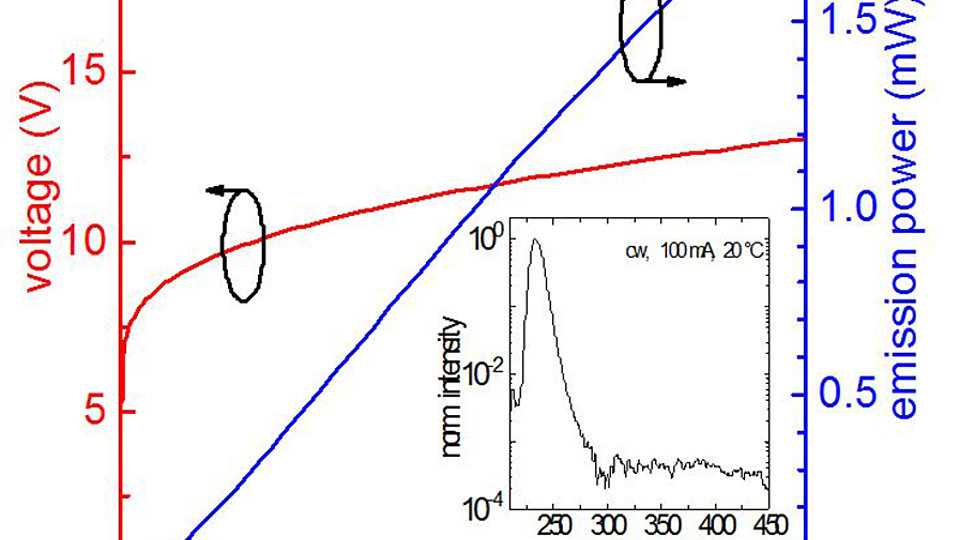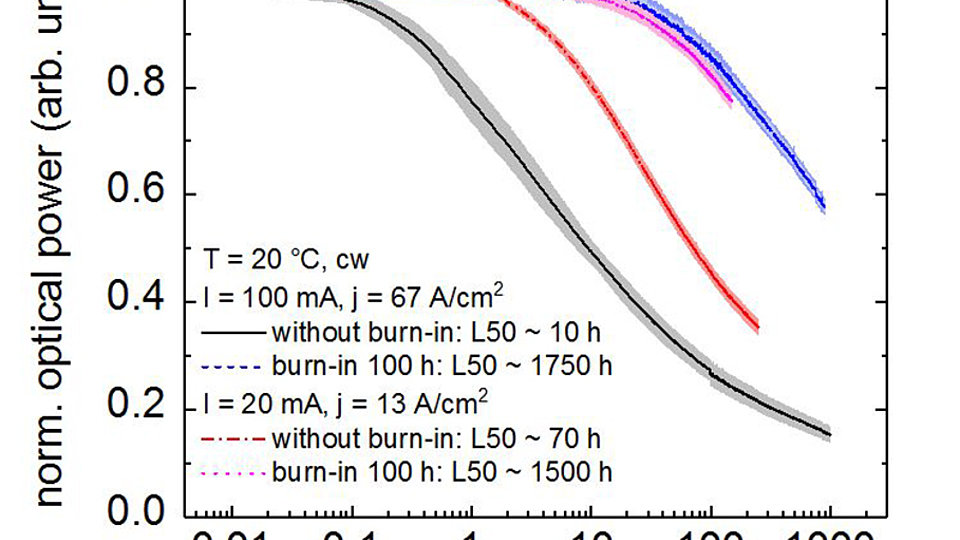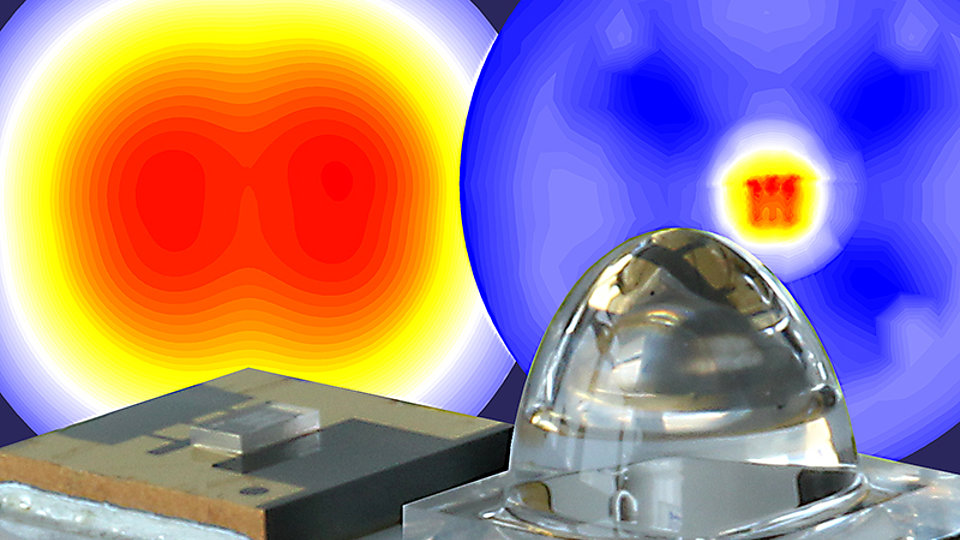Milliwatt power 233 nm far-UVC LEDs on sapphire substrates
Fig. 1. L-I-V characteristics of a typical packaged 233 nm flip-chip mounted LED. Inset: Spectrum of the LED with single emission peak measured at a dc current of 100 mA.
Fig. 2. Mean value of the optical power, normalized to the value at t = 0 h and t = 100 h, as a function of operation time for a batch of 15 LEDs emitting at 233 nm operated at a temperature of 20 °C and a currents of 20 mA and 100 mA.
AlGaN-based far-ultraviolet light-emitting diodes (far-UVC LEDs) with emission below 250 nm are an attractive solution for a number of applications such as monitoring of gas concentrations, and measurement of nitrate in water. Recently, the possibility of using these far-UVC LEDs to destroy microorganisms without allowing resistances to develop has drawn particular interest. Their light does not penetrate into the living layers of the skin. It is therefore expected that the skin will not be harmed at all or will be damaged so little that the natural repair mechanisms compensate for the effect. However, fabrication of high-power devices at wavelengths below 250 nm is challenging.
Within the framework of the Joint Lab GaN Optoelectronics, the Ferdinand-Braun-Institut (FBH) and Technische Universität Berlin (TUB) have developed 233 nm AlGaN-based far-UVC LEDs with a previously unattained emission power and lifetime. In order to reach this performance, several steps in the LED fabrication chain were optimized including the use of low defect density epitaxially laterally overgrown AlN/sapphire substrates, the development of vanadium-based low resistivity n-metal contacts, and finally the use of high thermally conductive AlN packages.
The electro-optical characteristics of a flip-chip mounted far-UVC LEDs with a single peak emission wavelength of 233 nm is presented in Fig. 1. Due to the challenges in obtaining low resistance metal contacts, the operation voltage of the LEDs is 13 V at 100 mA, corresponding to a nominal current density of 67 A/cm2. The far-UVC LEDs exhibit an emission power of 1.9 mW, at a current of 100 mA, corresponding to a wall plug efficiency of 0.14 % and the highest external quantum efficiency demonstrated to date of 0.36 %. The emission power of the 233 nm LEDs is strongly influenced by the device temperature. A nearly 74 % decrease in the emission power, measured at 100 mA, is observed when the heat-sink temperature is increased from 20 °C up to 80 °C. In comparison, a 310 nm LED shows only a 35 % decrease in emission power, at 100 mA, for the same change in heat-sink temperature.
The degradation behavior of the 233 nm LEDs was investigated at constant currents of 20 mA and 100 mA. The typical evolution of the optical power is depicted in Fig. 2. Two different degradation modes are observed: A fast current-dependent decrease in the emission power within the first ~100 h of operation and a slow decrease of the emission power beyond 100 h, which is almost independent of the current. To obtain stable operation of the 233 nm LEDs, a burn-in is required. With a burn-in of 100 h, estimated L70 lifetimes of ~380 h and L50 lifetimes of over 1500 h can be achieved for the 233 nm LEDs operated at 100 mA and 20 °C.
This work was supported by the German Federal Ministry of Education and Research (BMBF) within the “Advanced UV for Life“ project under the contracts 03ZZ0146C and 03ZZ0146D and by the Deutsche Forschungsgemeinschaft (DFG) within the Collaborative Research Center “Semiconductor Nanophotonics“ (SFB 787).
Publications
[1] N. Lobo Ploch, F. Mehnke, L. Sulmoni, H.-K. Cho, M. Guttmann, J. Glaab, K. Hilbrich, T. Wernicke, S. Einfeldt, and M. Kneissl, “Milliwatt power 233 nm AlGaN-based deep UV-LEDs on sapphire substrates”, Appl. Phys. Lett., vol. 117, no. 11, pp. 111102, DOI: 10.1063/5.0015263 (2020).
[2] F. Mehnke, L. Sulmoni, M. Guttmann, T. Wernicke, and M. Kneissl, “Influence of light absorption on the performance characteristics of UV LEDs with emission between 239 and 217nm”, Applied Physics Express 12, 012008 (2019).
[3] L. Sulmoni, F. Mehnke, A. Mogilatenko, M. Guttmann, T. Wernicke, M. Weyers, and M. Kneissl, “Electrical properties and microstructure formation of V/Al-based n-contacts on high Al mole fraction n-AlGaN layers”, Photonics Res., vol. 8, no. 8, pp. 1381-1387 (2020).
[4] J. Glaab, J. Ruschel, F. Mehnke, M. Lapeyrade, M. Guttmann, T. Wernicke, M. Weyers, S. Einfeldt, and M. Kneissl, “Degradation behavior of AlGaN-based 233 nm deep-ultraviolet light emitting diodes”, Semicond. Sci. Technol., vol. 33, no. 9, pp. 095017 (2018).


